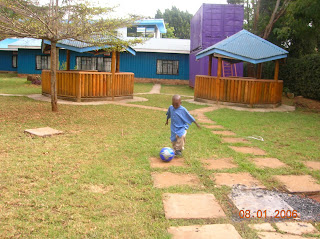
“Ewuaso Kdong”
Our next stop that day was the Compassion center at Ewuaso Kdong. Earlier in the week, when we had visited the Compassion center in Nairobi, we thought we knew what Compassion was doing for its sponsored children. But here in the tiny village of Ewuaso Kdong, where three of our team members had children, we actually got into the guts of Compassion, some of us more so than others.
Michelle, Amanda and the Bells got to meet the children they sponsor and to commemorate the visit they each planted an avocado tree. We all split up then so that we could each go to the home of one of the children. Geoff, Cathy and I went with Michelle to the traditional Maasai home of her little boy.
The homes of the Maasai are usually within a manyatta. A manyatta is a group of small family homes surrounded by a fence made of brush piled around the perimeter. At night, the family’s herds of goats or cattle are brought within the fence for safety and to keep them from wandering off. Extended family and one man’s several wives and children live in the different small homes throughout the manyatta.
And by small home I mean a stick and mud hut somewhere around fifteen feet square.
Since they don’t have doors, to get into the home we went through a narrow opening, turned sharply in one direction and then the next, ducking the whole time as the ceiling was less than five feet high. In the tiny room we found ourselves in there was a small open fire, a few shelves for cooking gear, a bench that the four of us sat on elbow to elbow, a bed and not much else.
Our host gave us each a cup of steaming hot chai tea, which would be ok on a winter day –oh that’s right, it was winter in Kenya. Yet the temperature in this mud hut had to be close to 100 degrees. I know that you can buy chai tea all over now in the US, but I have yet to find any that is anywhere close to the chai we drank with the Maasai. Made with boiling goat’s milk and lots of sugar, it reminded me of some weird melted ice cream. The first couple sips, once it cooled off enough to drink, were really good, but it didn’t take long for it to taste just too sweet. And for me to say that, you know it had to be sweet.
Over in the home of Amanda’s Compassion girl, however, in addition to chai tea, Amanda, Val, Kari and Jon were served the next most common thing in the Maasai diet – goat meat stew. Along with whatever vegetables are available, usually potatoes and cabbage, the Maasai will throw in just about everything from the goat, including some of the internal organs. Val, lucky girl that she always is, got to have some of the guts on her plate. Of course, she didn’t know that until the little hairs, the villi from the inside of the intestine, got stuck between her teeth.
That probably still wasn’t as bad though as the raw goat kidney certain members of our team are going to encounter in a couple days.





































